London has the red double-decker bus, New York the yellow taxi, and the Philippines has the Jeepney.
I have never heard of “jeepney” before, but once I travelled to the Philippines, I had to add this word to my travel vocabulary list. In today’s post, I want to introduce this extremely interesting vehicle and transport to you and I hope you will have a chance to have a ride on one some day.
Best way to experience the Jeepney ride, of course, is to go to the Philippines! Here’s a handy Philippines Travel Itinerary for you.

You can experience the magic of Jeepneys first-hand with a Jeepney Tour from Manila.
Quick Navigation
ToggleWhat is Jeepney?
Jeepney is the Philippines’ most popular mean of public transport, extremely cheap and pretty comfortable, used by most of the locals. It is also known as Jeeps and in Filipino you would call it Dyipne or Dyip.
Because of its open rear door design, picking up and dropping off is easy for both passengers and drivers, although there’s quite a lot of shuffling inside.
Each vehicle represents the multi-cultural history of the Philippines.
As one of first makers of Jeepneys, Ed Sarao says: “There is bit of Spanish, Mexican traits there; how they incorporate vivid colors, fiesta-like feelings. There is a little of the Americans because it evolved from the Jeep. There is a little Japan because of the Japanese engine. But it was built by Filipino hands.”
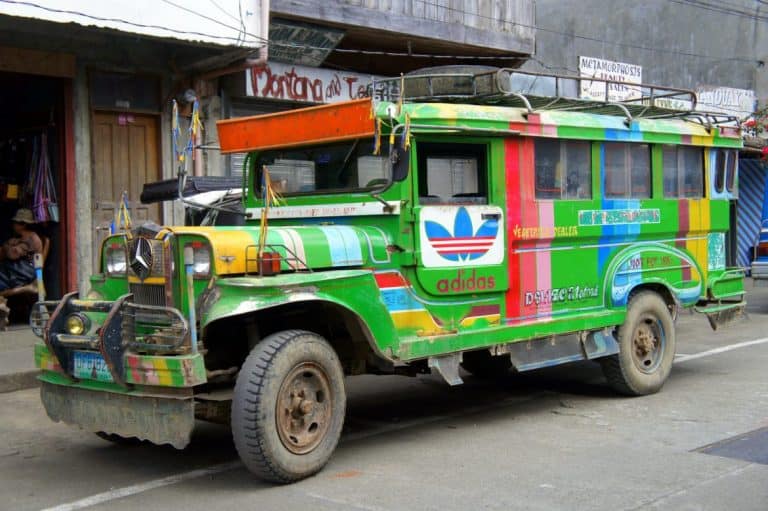
The bulk of Jeepneys are built from second-hand Japanese trucks, originally intended for cargo. It is devoid of passenger comforts. Depending on length, it can load from 18 to 30 passengers, the drivers are usually waiting for a full load before going their way, but that may differ depending on the route (drivers know best what’s the most profitable way for them).
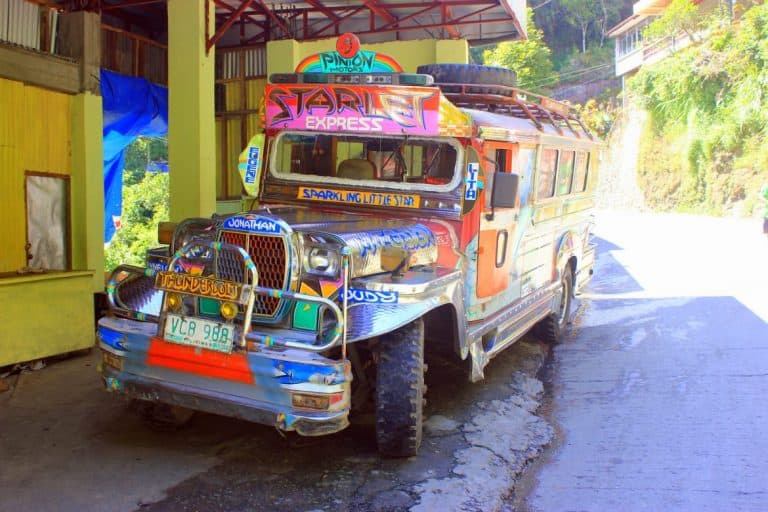
What is so special about Jeepneys?
They all qualify as “art-on-wheels”! Probably no two jeepneys are alike. The jeepney art is impressive and it is a combination of artwork applied by airbrush and sticker artists.
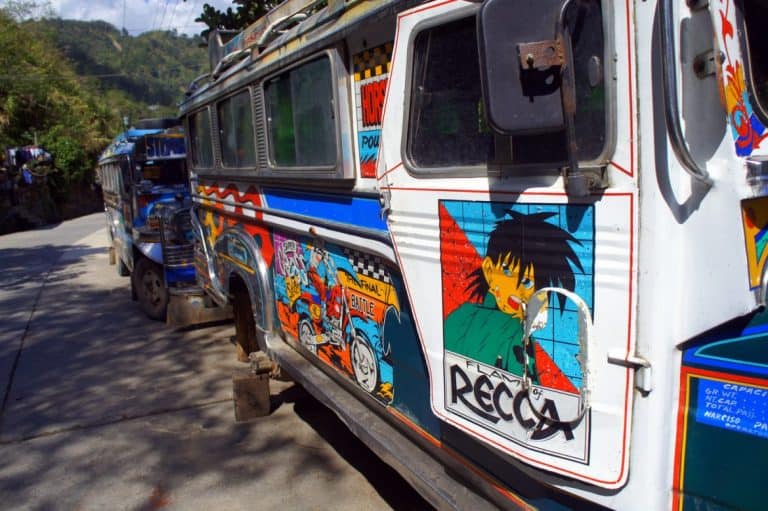
Many jeepneys concentrate the art on the front, insanely cramming the hood area with accessories, the sides with empty galvanized expanses or scatterings of ads and small art. Some are gleamingly and colorfully wrapped with accessories and airbrushed or stickered art. The main art theme are religious symbols.
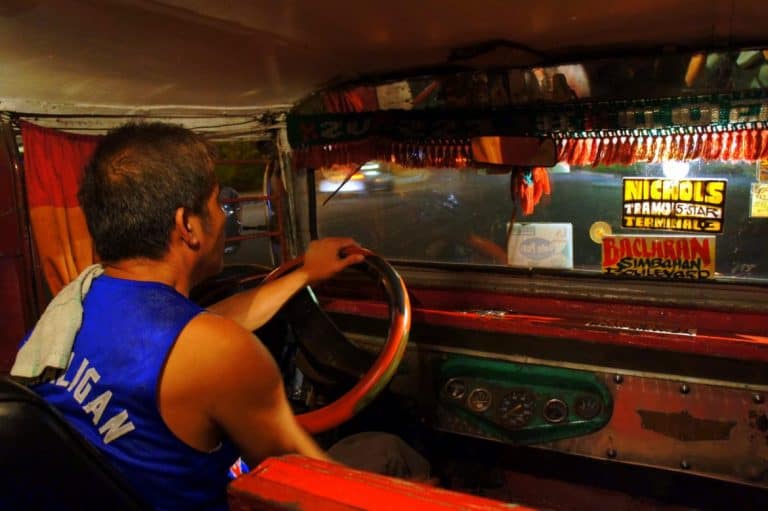
Where can you find Jeepneys?
The answer is EVERYWHERE in the Philippines! During the day they go on fixed routes, picking up passengers from designated stops. There are roughly 50,000 Jeepneys roaring around Manila on any given day so there is no way you won’t spot at least 1 when strolling down the streets or even through the tumbling hills of Corderilla.
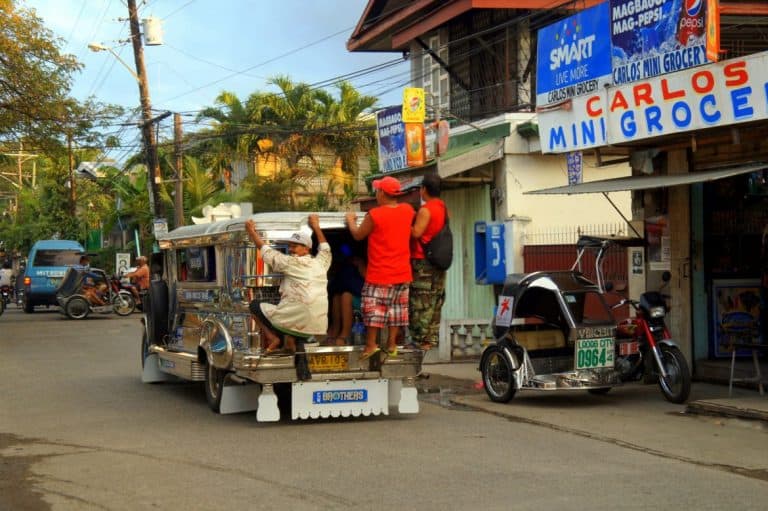
How Much is the Jeepney Ride?
Getting around may cost as little as 8 pesos which is $0.20. However, different routes / distances/ cities may have different prices. For an average Filipino, jeepneys are the cheapest way to get from one place to another, without walking.
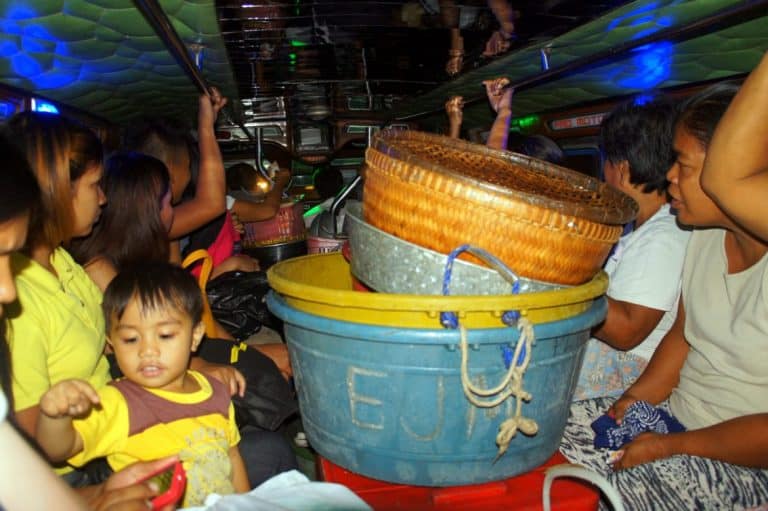
For budget travelers, jeepneys are one of the best and most comfortable transport options, especially if you travel in a group. Drivers normally speak English (like most of the Filipinos) so you can easily get to your destination for a few cents.
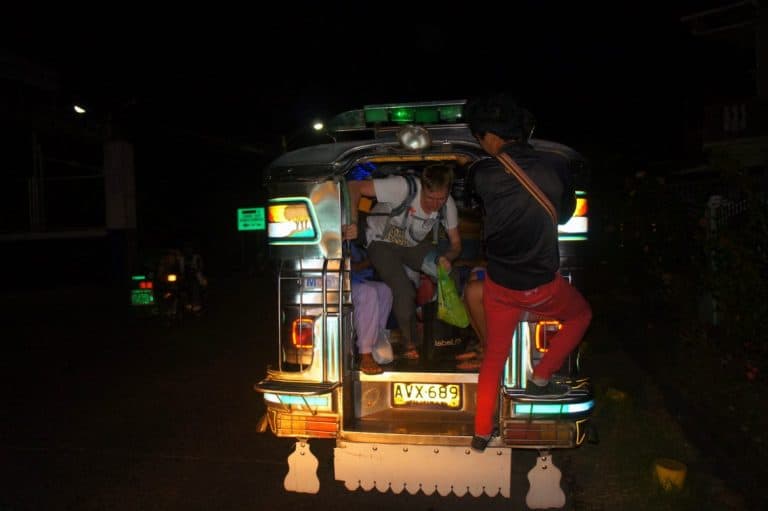
What it’s Like to Ride in a Jeepney?
Pros of Jeepney:
- Picking up and dropping off is easy for both passengers and drivers, they can stop anywhere unlike buses. You can catch one from nearly any place you are at.
- It’s a good opportunity to talk to some locals and get to know people.
- Less likely you’ll get ripped off (the prices are normally fixed) unlike some buses and most taxis.
- There is plenty of space inside to sit down and unfold your legs (unless it’s fully packed).
- Budget-friendly mean of transport in the Philippines.
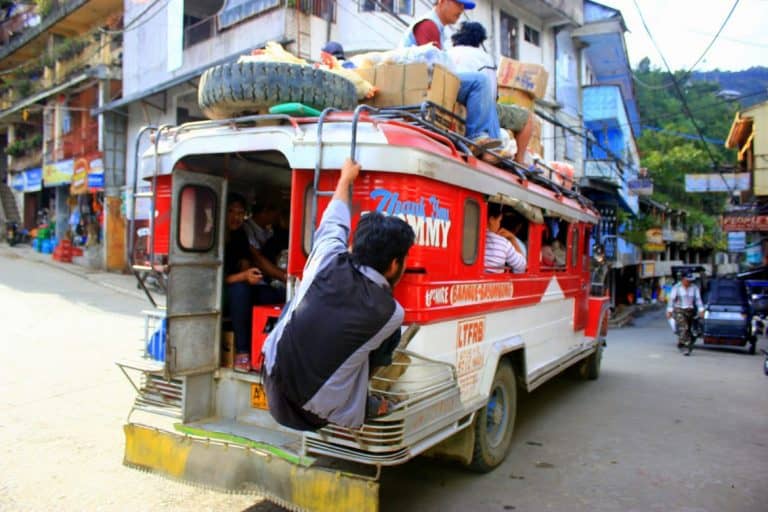
Cons of Jeepney:
- There is no air-conditioning.
- Not much will protect you from the elements (imagine a ride in the rain).
- It’s not very safe (no seat belts and drivers drive like crazy).
- Most of the jeepneys are overloaded with passengers so you might end up squeezed feeling like being in a can of sardines (shoulder-unto-armpit, back-unto-chest, shoulder-unto-shoulder, elbow-unto-hipbone).
- Sometimes, your wheeled backpack will ride on the roof instead of next to you,
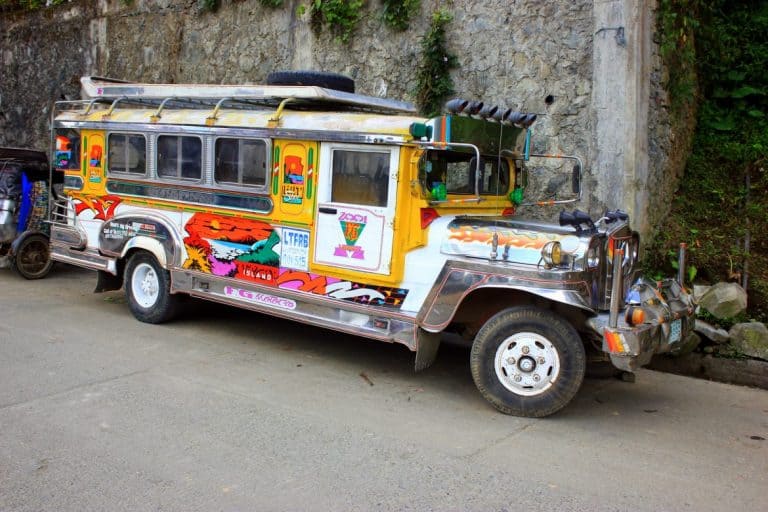
Our experience with Jeepneys
We took our first jeepney right after we arrived at Manila airport. We caught it just outside the airport to get to the bus station from where we were going to Pagudpud. It was easy to get in and cheap, pretty shaky ride, but safe and we enjoyed it. The driver didn’t talk much, but he knew the place we were heading to so he dropped us off just in front of the bus station. We paid 8 pesos each. There were only 5 other passengers with us. It was fun! Afterwards, we had at least one ride in every city we’ve been to.
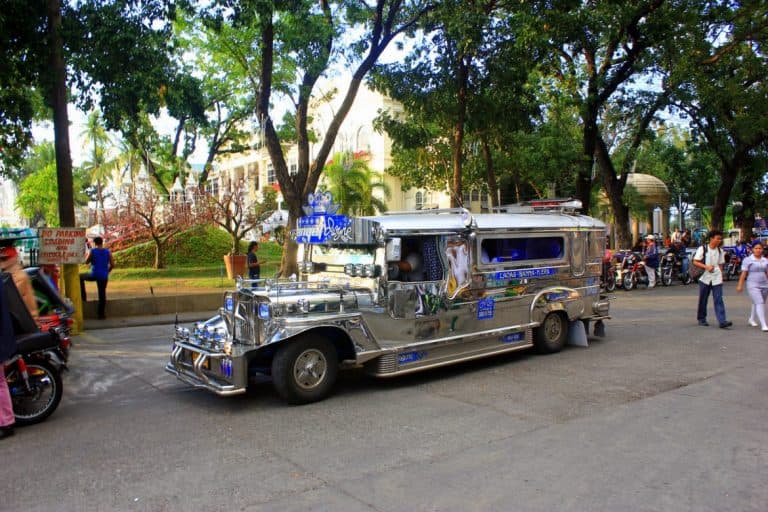
Have you ever had a jeepney ride? If so, how was it?



77 thoughts on “What the Heck is a Jeepney?”
GREAT photos in this post. I especially love the one of the Jeepney at night, just stuffed full of people and paraphernalia!! I don’t use jeepneys so often because I’m a lazy ass who prefers to just get there in a taxi, but I’ve loved the experiences when I have taken them. They are definitely one of those iconic cultural aspects of the Phils :)
Mike, are you a taxi guy? Shame on you LOL! We’re cheap people!
They really look like you’re having a fun time taking them. I love those unique characteristics of a country’s culture. As you said it, it’s like the double-decker in London. I really haven’t heard of it before. So thanks for sharing. I will remember this and catch a jeepney once in Manila (nothing planned yet).
Trust me, it was a lot of fun! :) If you need some help with planning, you know where to find me, right :)?
There are similar vehicles in Colombia, Ecuador, Haiti…
But the Philippine Jeepneys have more notoriety, they’re legendary, even…
Seriously? I thought jeepneys are common in the Philippines only.
Yes, but they have different names. Basically, they-re also tuned-hyper-decorated vehicles…
Nice article!! Hope you can visit philippines again and experience mpre about our cultures! hahaha.,
Hey! Thanks a lot. I hope to make it there once again.
Jeepney is not the only cheapest way for transportation here in Philippines. They are commonly found in Luzon and Visayas. But in Mindanao, we have motor vehicle here, in which a motorcycle has “side car”. It can carry 4-6 passengers depending on the motor vehicle, if it has 2 seats or 1. I like to sit on the back ride, which is at the back of the driver. You must try it :) It’s cheap too.
Are motor vehicles cheaper than jeepneys? I thought jeepneys prices cannot be beaten! I will try them when I’m back in the Philippines. Thanks for that! x
“There is bit of Spanish, Mexican traits there; how they incorporate vivid colours, fiesta-like feelings. There is a little of the Americans because it evolved from the Jeep. There is a little Japan because of the Japanese engine. But it was built by Filipino hands” – LOVE IT!!! How awesome is that!?!
I have a secret ambition (well, maybe “inclination” is a more appropriate word) to try the most ridiculous and offbeat forms of transport possible. So far, the back of a cargo-truck in Kyrgyzstan is the top of my list!
I get what you mean. For me it’s a DIY tractor in Laos :D
Hey Agnes,
I enjoyed reading this article about jeepney. It’s my first time to appreciate the jeepney we have back home after having been living for six years in Bangkok. Back home, jeepney was the kind of transportation I avoided to take on going to the market, school or anywhere because many drivers were reckless esp. in Mindanao. They tend to drive off before you step inside or step on the ground to get off. You should have seen how most men ride jeepneys on the rear end and jump down before the jeepney stop to drop passengers. That scene I always love to watch because only few men who were not expert got bruises when they landed. In my hometown, men tend to do such exhibition especially when many young ladies are watching on the road.
Hey Chem,
I’m glad to hear that and thank you so much for sharing x
Jeepneys make me miss the Philippines a lot these days :).
Wow! You ain’t going to miss those, they look cool! I love how they always cram people on, no thought for health and safety. Imagine if they did this in London, there would be outrage :-)
HAHAHAHHA, so true Rob :D!
Yay! I’m a filipino,great article. All you’ve said are true and that’s how all commuters feel. But,you know,we just get used to it. :)
Hi Pin! Cheers! :)
I have my own opinion about how confortable the jeepneys are, especially when entering with the backpack and the make you seat in the further seat by the back of the driver.
I did also loved the jeepney and the sensation of not being ripped off like the tricycle where a plus :)
Some jeepneys looked way too over-packed :D!!
It didnn’t occur to me that they were like the red buses of London and Yellow Cabs of New York which is a pretty interesting perspective. Now I regret losing them soon. They are far more trustworthy and safer than taxicabs. Unortunately, due to popular demnd among the locals, the Jeepney will be phased out soon to give way to electric vans and mini buses. The Jeepney has been the national icon but has been the main causes of polution, traffic jams and raod accidents in Manila. We will miss you Jeepney.
Well, there was a time when Manila was connected by ril trams much like those in San Francisco. They were phased out after the World War Ii. Hmm, I think that was probably the story of the jeepney. The locals used U.S. Military jeepneys to replace the trams after the war after the city was falttened during World War II, the second most destroyed city in the world after Warsaw, Poland I believe.
Hey Marlo. Interesting comment. Yes, jeepneys are so much like red buses in London and yellow cabs in New York – you just can’t miss a ride! It’s so sad to know jeepneys will be phased out soon to give way to electric vans and mini buses :-(. Let’s hope there will be still some around for tourists to have a ride!
I’m so glad you guys had a great over all experience with riding the Jeepneys. They are quite a sight but also wonderful national icons. I have many fond childhood memories riding them and quite memorable experiences. Great collection of photos.
I am glad you have such great memories from the Philippines!
It must be fun to have a ride on a jeepney. I’d try it for sure!
It is A LOT of FUN!
What an amazing word jeepney. It sounds like the female version of the jeep in Hindi. Nice set of pictures of the jeepney.
I also like its name.
Hi Agness, I grew up riding jeepeys, It was just those part of daily life of living in the Philippines. Tricycles (motorbike with a side care) are also normal mode of transport for short distances within town. They can be very colorful and artsy, too. I still love taking them when I visit the Philippines. Riding them can be more fun in the provinces than in Manila because the traffic is less crazy and air is less polluted. Nonteheless, it’s a good cultural experience for any visitors. I’ glad you enjoyed the ride.
You’re right, jeepneys are, basically, everywhere!
Mindanao areas have less colorful versions of jeepneys and they ply longer routes.
Looks like you had fun!
cheers!
I noticed the bald tires on most jeepney photos I seen round the net. Are there no laws there to protect pasengers? Philippines is a backward country so be careful moving around.
They aren’t japanese trucks…? Jeepneys were created from the leftover army vehicles from World War II (eventually made and lengthened over the years but originally were kept the original size of the jeeps the US brought over – hence the name… JEEPney). Filipino’s are avid recyclers and will always find another use for something and instead of tearing down and dumping the US Jeeps they created these to act like smaller buses. They also recycle coconut husks by shredding it all up and stuffing them into the leather as the jeepney seats.
I feel as though you are a very close minded amateur traveller posing as a travelling connoisseur… do better research next time.
@Anna
The article says “jeepneys are BUILT FROM second-hand Japanese trucks”, which is very true according to my research. Where did you read that “jeepneys are japanese trucks”?
One look at a jeepney and it’s obvious it’s not a Japanese truck because those trucks are well designed, unlike jeepneys. Japanese trucks are export quality, while jeepneys, well… which country imports jeepneys from Philippines?
I hope it’s clear that jeepney materials are mostly from boneyards in Japan, chopped up old delivery trucks then shipped to Philippines.
We had a filipina (a housemaid, so to speak) and she told me some amusing stories about jeepney when she was in university, and while reading your blog I just felt like being transported back to my childhood days. Thanks for the nice blog!
I’ve heard there’s a sense of teamwork in commuting in a jeepney in terms of paying a transportation fee. I’ve also that the risk of getting robbed is high in riding jeepneys.